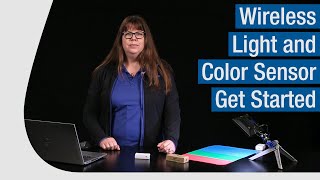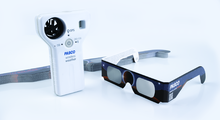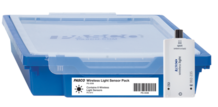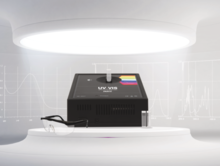
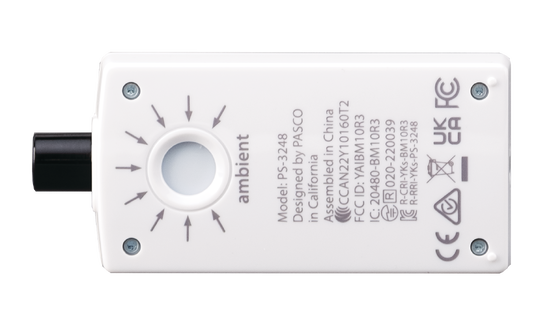










The Wireless Light and Color Sensor features an ambient and a directional RGB color light measurements.
See the Buying Guide for this item's required, recommended, and additional accessories.
Product Summary
The Wireless Light and Color Sensor features two separate apertures: One measures ambient light from the side of the box, and the other measures percent color of directional light at the end of the box.
Features
The ambient sensor measures:
- Lux: light energy from a point in a direction (per steradian, a solid angle) per second
- Illuminance: Light intensity per area, or brightness in our eyes’ perceivable range
- Irradiance: Power of the light per area. (Depends on wavelength as UV light has more energy than infrared)
- PAR (Photosynthetically Active Radiation): amount of light in the visible range 400 -700 nm available to stimulate plant growth
- UV Index: 1 to 12 scale for the time light takes to cause skin damage. (Larger numbers cause burns faster.)
The directional spot sensor measures:
- RGB: Light levels as a percent of the total of all colors measured
- White: Total 'white' light intensity as a function of the sensor (on a scale of 65,536)
Applications
- Studying solar energy
- Reflection, absorption, and transmission of light through clear, opaque, and variously colored translucent mediums.
- Investigating polarization and reflectivity
- Modeling planetary motion
- Verifying the inverse square law
- Investigating insolation (solar radiation) and seasons
- Indirect PAR measurements for biological studies
Product Specifications
| Spectral Response | 340 nm to 1150 nm |
| Illuminance Range | 0 to 131,000 lux |
| Irradiance Range | 0 to 1362 W/m2 |
| PAR Range | 0 to 2400 umol/m2/s |
| UV Index Range | 0 to 12 (typical in daylight) |
| RGB Range | 0 to 100% of combined colored light |
| Maximum Sample Rate | 2 Hz (ambient); 20 Hz (spot) |
| Connectivity | Bluetooth 5.2 |
Battery & Logging
| Datalogging | Yes |
| Stored Data Points (Logging) 1 | >15,000 |
| Battery - Connected (Data Collection Mode) 2 | >210 hr (2-3 years of normal classroom use) |
| Battery - Logging (Data Logging Mode) 3 | 11 days |
| Battery Type | Coin Cell |
1 Minimum # of data points with all measurements enabled, actual results depend on enabled measurements.
2 Continuous use in a connected state until battery failure, actual results will depend on sample rate, active measurements, and battery condition.
3 Logging until battery failure, actual results will depend on sample rate, active measurements, and battery condition.
* Normal classroom use is the sensor in active use for 20min/lab for 120 lab periods/yr.
Data Collection Software
This product requires PASCO software for data collection and analysis. We recommend the following option(s). For more information on which is right for your classroom, see our Software Comparison: SPARKvue vs. Capstone »
Connectivity Options
This product can connect directly to your computer or device with the following technologies. No Interface required. See the following guide for details regarding device compatibility: Wireless Bluetooth Product Compatibility »
Buying Guide
| Recommended Accessories | P/N | Price |
|---|---|---|
| Storage Tray for Wireless Light Sensor and AirLink | PS-3594 | -- |
| Replacement Parts | P/N | Price |
|---|---|---|
| Coin Cell Battery Pack | PS-3504 | -- |
| Also Available | P/N | Price |
|---|---|---|
| USB Bluetooth Adapter | PS-3500 | -- |
Product Guides & Articles
Select The Right Light Sensor
PASCO light sensors provide students with an accessible method for visualizing real-time light data in a variety of forms. Whether you’re looking to study ambient light, diffractions, or atomic spectra, this page will help you find an affordable light sensor for your applications.
Experiment Library
Perform the following experiments and more with the Wireless Light and Color Sensor.
Visit PASCO's Experiment Library to view more activities.
Weather in a Terrarium
In this lab, students will design and conduct an investigation of weather using a closed system, weather sensor, and light sensor to help identify independent variables, dependent variable, and controlled variables.
Can Plants Survive without Light and Water?
In this lab, students use a light sensor to explore whether plants need light and water to survive and what adaptations help them survive.
Seasons
In this lab, students will use a light sensor to investigate the relationship between the earth's tilt on its axis, its revolution around the sun, and the seasons.
How a Greenhouse Works: Light
Students change the angle at which light strikes a model greenhouse and measure its intensity.
Can Plants Survive without Light?
Students measure the ambient light around three plants for a series of days to discover the best light conditions in which they can grow.
Night and Day
In this lab, students use a light sensor to measure the light level that falls on a simulated earth's surface as it turns through several rotations.
Sunlight Intensity and Reflectivity
In this lab, students will use a light sensor, a fast-response temperature probe, and a stainless steel temperature probe to explore the concept that air temperatures near the earth's surface result largely from the interplay...
Solar Eclipse Light and Temperature Study
In this lab, students use Wireless Light and Temperature Sensors to investigate a solar eclipse and its impact on environmental conditions.
Intensity of Light
Students measure the intensity of a light source vs distance. Using their data they explore the mathematical relationship between intensity and distance and discover the inverse square relationship.
How a Greenhouse Works: Light
In this lab, students use a light sensor to determine how light or brightness depends on the angle at which the sun’s light strikes the surface of the ground and how this changes throughout the day.
Light and Dark
In this lab, students use a light sensor to determine how light is related to what they see.
Hunting with Light
In this lab, students use a light sensor to compare how organisms, including humans, are able to see. Then, they will compare the light sensitivity of organisms to what an electronic light sensor can detect.
Support Documents
| Manuals | ||
|---|---|---|
| Lithium Battery Safety Data Sheet | English - 129.01 KB | |
| Wireless Light and Color Manual | English - 519.00 KB | |


